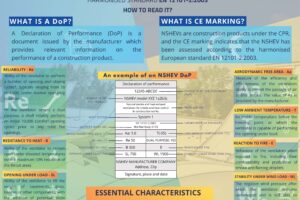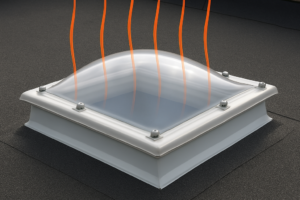In fire safety design, Natural Smoke and Heat Exhaust Ventilation Systems (NSHEVS) play a crucial role in ensuring safe evacuation of the occupants and limiting fire damage in the building.
In Poland, some parts of NSHEVS, like many other fire safety products, require additional certification before they can be legally installed on the Polish market. The key certification for NSHEVS is the Certificate of Admittance (pol. Świadectwo Dopuszczenia), issued by the Centrum Naukowo-Badawcze Ochrony Przeciwpożarowej (CNBOP), Poland’s leading fire safety research centre.
What is a Certificate of Admittance (Świadectwo Dopuszczenia)?
The Certificate of Admittance[1] is an official approval certificate that confirms a product’s compliance with Polish fire safety standards. It verifies that specific parts of NSHEVS have undergone extensive testing, meet all technical and regulatory requirements, and are fit for use in fire safety systems.
NSHEVS Products Requiring Certification
According to the list of products subject to the process of admittance of products for use in fire protection[2], several NSHEVS components require a Certificate of Admittance to be legally marketed in Poland. These include:
- Smoke Control Panels (WTU 12.1): Devices that manage the operation of the smoke control system, ensuring effective ventilation during a fire.
- Emergency Power Supplies (WTU 12.2): Backup power systems, such as batteries, that maintain functionality during power outages.
- Manual Call Points (WTU 12.3): Devices that allow users to manually activate the smoke control system.
- Electromechanical Actuators (WTU 12.4): Mechanisms that physically open or close vents in response to smoke control system commands.
- Cables and Wires (WTU 14.1 or WTU 14.2): Cables used for powering and controlling smoke control devices, ensuring proper functionality during a fire event.
- Cable and Wire Fastening Systems (WTU 14.3): Systems that secure cables and wires, ensuring their integrity during a fire.
The Certification Process for NSHEVS
Obtaining the Certificate of Admittance for NSHEVs involves several detailed steps:
- Application Submission: Manufacturers or their representatives submit an application to CNBOP, detailing the product and its technical specifications.
- Testing: Products undergo rigorous testing at CNBOP to verify compliance with relevant standards and technical and operational requirements.
- Documentation Review: All technical documentation, including drawings, calculations, and previous test reports, is reviewed for accuracy and compliance.
- Factory Audit (if required): CNBOP may inspect the manufacturing facility to confirm production quality and consistency.
- Certification Issuance: Upon successful testing and review, CNBOP issues the Certificate of Admittance, typically valid for 5 years.
Consequences of Non-Compliance for NSHEVS
Using uncertified NSHEVS components can lead to significant risks and repercussions, such as:
- Safety Risks: Uncertified NSHEVS components may fail during a fire, endangering lives and property.
- Legal Penalties: Buildings with non-compliant systems may face fines or operational restrictions.
- Project Delays: Non-compliant systems can cause delays in obtaining occupancy permits.
- Insurance Compensation Denial: Uncertified systems could lead to insurance claims being denied, increasing financial risks for building owners.
The Certificate of Admittance is a vital certification for NSHEVS in Poland, guaranteeing their reliability and compliance with Polish fire safety standards and regulations. For manufacturers, it opens doors to the Polish market, while for designers and building owners, it ensures safety and compliance with Polish regulations.
References
[1] CNBOP Certificates of Admittance
[2] CNBOP List of products subject to the process of admittance of products for use in fire protection
CNBOP Guidelines for Staircase Smoke Ventilation Systems (PDF)




